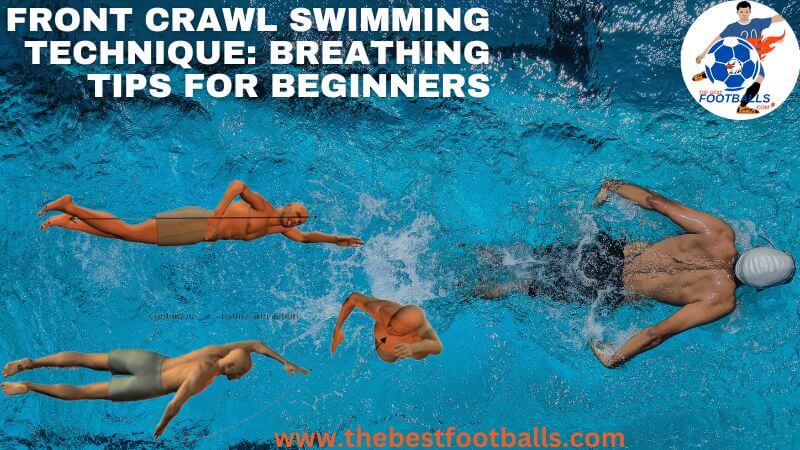Front crawl swimming, often known as freestyle, is an exhilarating and efficient stroke that allows swimmers to move swiftly through the water. However, mastering the technique, especially when it comes to breathing, can pose a challenge for beginners. Correct breathing is crucial to front crawl swimming, as various styles work differently for individuals. The nuances of front crawl breathing will be dealt with thoroughly throughout this piece, along with beginner-friendly swimming advice.
The Importance of Timing: Watching the Full Stroke in Action
Before diving into the specifics of breathing, let’s take a moment to observe the full front crawl stroke in action. This will help emphasize the significance of proper timing when breathing. A well-coordinated stroke and breathing rhythm are essential for maintaining momentum and efficiency in the water.
How to Get Started
If you’re new to front crawl swimming, the first step is to familiarize yourself with the basic stroke mechanics. It’s essential to have a comfortable and consistent stroke technique before focusing on breathing. Practice your arm movements, body rotation, and kicking until you feel confident in your stroke.
Breathing In and Out
Although it may seem strange initially, breathing while swimming is a talent that can be developed with practice. In the front crawl, turning your head to the side to breathe while one arm is extended forward is common. Remember to exhale gently through your nose and mouth while your face is submerged, and inhale quickly when you turn your head to breathe.
Explosive Breathing
Aim for quick and efficient breaths to maintain your body’s alignment and streamline in the water. This means inhaling rapidly as your mouth clears the water’s surface and exhaling immediately upon submersion. This explosive breathing technique ensures minimal disruption to your stroke’s rhythm and helps you maintain your pace.
How Often Should I Breathe?

Breathing frequency depends on your fitness level, stroke efficiency, and swimming distance. Breathe every two to three strokes to find a comfortable rhythm as a beginner. You can adjust your breathing pattern to suit your needs as you progress.
Breathing Tips
- Lateral Breathing while Flutter-Kicking with a Kickboard: To practice bilateral breathing (breathing on both sides), use a kickboard to focus solely on your leg movements. This will also help you become accustomed to breathing on your non-dominant side.
- Lateral Breathing while Flutter Kicking, and with Arms Extended Forward: Integrate your arm movements while continuing to practice lateral breathing. This stage allows you to coordinate your arm strokes with your breathing pattern.
- Swim Front Crawl with Fins, Always Breathing on the Same Side: Fins can provide additional propulsion and stability. While using fins, consistently breathe on one side to build your confidence and rhythm.
As you progress through these stages, gradually increase your swimming distance while maintaining a steady breathing rhythm. Practice is critical to improving your front crawl technique and breathing proficiency.
In conclusion, mastering the art of front crawl swimming requires patience, practice, and a keen understanding of breathing techniques. By following the steps outlined in this article, beginners can navigate the challenges of front crawl breathing and work towards a more enjoyable and efficient swimming experience. Utilize these pointers as part of your training program, and before long, you’ll be gliding through the water with comfort and confidence, making the front crawl your go-to swimming stroke.
Benefits of Proper Front Crawl Breathing
Apart from enhancing your swimming skills, mastering the art of front crawl breathing offers a range of benefits that contribute to your overall swimming performance and well-being:
- Improved Endurance: Efficient breathing techniques help conserve your energy, allowing you to swim longer without feeling exhausted. Proper breathing also prevents unnecessary strain on your muscles.
- Enhanced Oxygen Intake: Breathing correctly ensures a consistent oxygen supply to your muscles and brain. This increased oxygen intake boosts your stamina and concentration while swimming.
- Optimized Stroke Timing: Coordinating your breathing with your stroke rhythm prevents water flow disruption. This synchronization optimizes your stroke efficiency, making you a more effective swimmer.
- Reduced Anxiety: Mastering proper breathing techniques can help reduce anxiety associated with being in the water. Controlled and rhythmic breathing can be calming, making your swimming experience more enjoyable.
- Muscle Engagement: Proper breathing encourages a balanced body rotation, engaging core muscles effectively. This improves your swimming technique and contributes to overall core strength.
Common Mistakes to Avoid
As you work on refining your front crawl breathing, be mindful of these common mistakes that beginners often make:
- Holding Your Breath: Holding your breath while swimming disrupts your rhythm and causes unnecessary tension. Remember to exhale gradually while your face is submerged, and inhale quickly when you turn your head to breathe.
- Over-Rotation: While it’s important to rotate your body to breathe, over-rotation can lead to imbalance and affect your stroke efficiency. Aim for a controlled rotation that allows you to maintain a streamlined position.
- Late Breathing: Timing is crucial in front crawl breathing. Delaying your breath can cause you to rush your stroke, leading to inefficiency. Practice explosive breathing to ensure you’re inhaling at the right moment.
Breathing Drills to Enhance Your Front Crawl Technique

To further refine your front crawl breathing technique, incorporating specific drills into your training routine can make a significant difference. These drills target different aspects of your breathing and stroke coordination, helping you overcome challenges and become a more proficient swimmer. Let’s explore some effective breathing drills:
- Breathing Every 3 Strokes: Begin by swimming the front crawl and breathing every three strokes instead of the usual two. This drill encourages you to develop a balanced breathing pattern on both sides, enhancing your bilateral breathing skills. Gradually, as you become comfortable, switch back to your regular breathing pattern.
- Bubble-Bubble-Breathe: This drill focuses on exhaling consistently while your face is submerged and inhaling quickly when you turn your head to breathe. Count “bubble-bubble-breathe” as you exhale underwater, ensuring a continuous stream of bubbles before you live.
- Catch-Up Drill: In this drill, swim with a delayed arm recovery. As one arm extends forward, the other arm begins its pull. This exercise promotes controlled rotation and timing, allowing you to synchronize your breathing with your strokes effectively.
- Kickboard Lateral Breathing: Hold a kickboard before you and practice lateral breathing while maintaining a flutter kick. This isolates your breathing technique, helping you focus solely on coordinating your breaths with your body rotation.
- Fingertip Drag: While swimming, touch your fingertips to the water’s surface as your arm exits the water. This drill encourages proper arm extension and timing, preventing rushed strokes that can disrupt your breathing rhythm.
- One Goggle Out: Swim with one goggle partially out of the water during breathing. This drill helps you maintain proper head positioning during the breath, preventing excessive lifting of your head, which can slow you down.
- Swim with a Tempo Trainer: A tempo trainer is a device that emits beeps at a specific rhythm. Please set it to a tempo that matches your desired stroke rate. This helps establish a consistent and controlled breathing pattern by synchronizing your breaths with the beep cues.
- Focus on Exhalation: To improve lung capacity and control, focus on fully exhaling underwater before you turn to breathe. This ensures you inhale more efficiently during the breath phase.
Putting It All Together
As you incorporate these breathing drills into your training regimen, you’ll notice gradual improvements in your front crawl technique. Remember that consistent practice is critical to mastering any skill. Over time, your breathing will become more natural, and your stroke coordination will become second nature.
Front crawl swimming is a blend of skill, technique, and determination. By paying careful attention to your breathing and incorporating these drills, you’ll be well on your way to becoming a confident and capable front crawl swimmer. Keep challenging yourself, embrace the learning process, and enjoy the accomplishment of conquering the challenges of front crawl breathing.
Summary
Front crawl swimming is a dynamic and exhilarating stroke requiring effective technique and proper breathing. As a beginner, take your time with initial challenges. Instead, view them as opportunities to learn and grow. With dedicated practice, patience, and the implementation of breathing tips and drills, you’ll gradually become a skilled front crawl swimmer.
Remember, every stroke, every breath, and every practice session contributes to your progress. Stay consistent, maintain a positive mindset, and celebrate each milestone along your journey to mastering the art of front crawl swimming. As you refine your breathing technique and stroke coordination, you’ll experience the joy of gliding effortlessly through the water, making front crawl swimming an enjoyable and rewarding experience.



